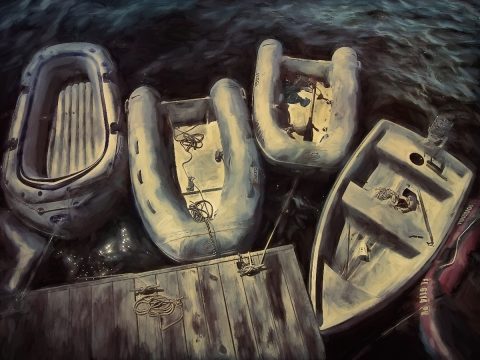What does the narrator do while she’s at the beach?
Goleta Beach extends for miles, wrapping around Isla Vista and the university. It’s a beautiful and contemplative walk in either direction, and when I lived in the dorms, I would stroll for hours, sometimes alone and sometimes with a friend. That’s what the narrator is doing—going for long walks, and sitting down for a minute here and there.
My dad tells a story of his father burning a chair in front of their house when he was a child. What the hell is the matter with people?
It’s certainly not a safe or responsible thing to do. I think the pieces of burned furniture in Isla Vista stick with me more so than the people who set them on fire, or rather the people who set those fires exist to me as more of an absence made even more obvious by the furniture they’ve left behind. In the middle of the summer in Isla Vista, you might go for hours without seeing another person outside. But, then, you know they’ve been there because some time in the night, they set something on fire and left it in the street or at the end of your driveway.
What are some operational considerations of selling food and beverages as a child? I never ran a lemonade stand as a kid. I barely even sold popcorn as a Cub Scout.
My siblings and I occasionally had impromptu garage sales with our Pokémon cards and Beanie Babies, and once a lemonade stand. Our first goal was to get the most money possible for our wares, probably to buy sour gummy worms at Rite-Aid. I was such an earnest child, though. I didn’t have a haggling bone in my body. I would give anything away at whatever price you named. I was more moved by the idea that a stranger might want this thing that I had, and that I could give it to them.
In her book, Steering the Craft, Ursula K. Le Guin lists five principal points of view in narrative as limited third person, involved/omniscient author, detached author, observer-narrator using the first person, and observer-narrator using the third person. So just what do you think you’re doing here?
Pam Houston’s “How to Talk to a Hunter” shaped how I use the second person. In an interview, Houston writes, “I personally love the second person. Not for every situation, but when it is right it is so right. In the first place, it is the language of the American street corner. ‘So you are standing there, and this guy comes up to you.’ … Also, it nicely deflects responsibility and is, therefore, essentially American. It creates a wash of shame over a narrative presence who doesn’t quite want to ’fess up, who doesn’t quite want to say ‘I.’” Houston says it so succinctly, it’s impossible not to call upon her here.
In this story, the narrator distances herself from the loneliness and the self-destructive impulses she’s describing through the use of “you” and yet still betrays such intimate knowledge through the abundance of detail. There’s a tension there that allows the story to be a specific portrait of this person’s loneliness and avoids being sentimental or self-pitying.
Is the appearance of Rolling Rock beer cans specifically indicative of the campus culture at UC Santa Barbara, or is that a universal college thing?
Rolling Rock and PBR are the two brands I saw most often at parties in Isla Vista. Details matter to me because they evoke a specific place and time, but they also create a bridge between the reader and the narrative—someone who didn’t go to UCSB or has never been to Isla Vista has still been to the kind of house party where beer pong, king’s cup, or flip cup was played with Rolling Rock. So they know what kind of party, what kind of people, what kind of place I’m talking about when I tell you what kind of beer they were drinking. There’s a very specific mood at that party, and it’s signaled to you by the discarded cans of Rolling Rock bobbing in the hot tub. Details are my favorite way to anchor the emotion of a scene—they can do so much in such little space.



 The SmokeLong Grand Micro Contest (The Mikey) is now an annual competition celebrating and compensating the best micro fiction and nonfiction online.
The SmokeLong Grand Micro Contest (The Mikey) is now an annual competition celebrating and compensating the best micro fiction and nonfiction online.